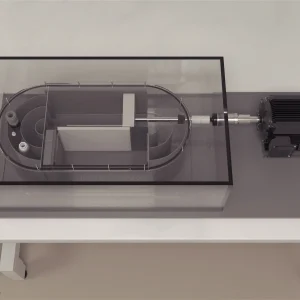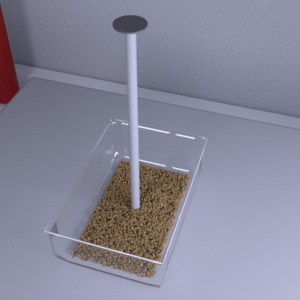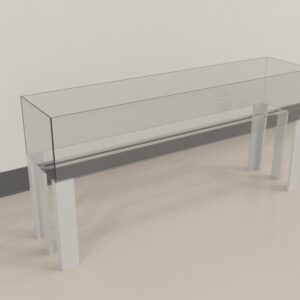$1,490.00
The MazeEngineers rodent climbing tower is a specialized housing unit designed to promote physical activity in rodents. Constructed with a steel wire mesh featuring cross stripes approximately 5 mm apart, the tower facilitates climbing and exercise. Standing 100 cm tall, the tower is designed to encourage mice to engage in voluntary climbing behavior. Water bottles are positioned at the top of the tower, motivating the mice to climb in order to access hydration. The setup includes a bottle for this purpose, providing a practical incentive for the rodents to ascend the tower. This design not only supports the rodents’ physical health but also allows for behavioral observations related to climbing activity.

MazeEngineers empowers preclinical neuroscience research with meticulously designed, customizable behavioral apparatuses. From manual classic mazes to fully automated smart systems, we provide the tools scientists need to capture high-quality, reproducible data for studies on learning, memory, anxiety, and depression.

bool(false)


Mouse / Rat |
100cm height climbing tower |
20cm width diameter tower |
Cage |

The Mouse Resistance Exercise System (MRES) is a climbing tower used to study the role of mechanical loading in the maintenance of bone mass and strength. It can also be used to study changes in skeletal muscle and abdominal fat content after resistance exercise. Resistance exercise system (RES) was first developed by Yarasheski et al., to study effects of heavy-resistance exercise training on the skeletal muscle fiber composition of young rats. Many years later, Duncan et al., designed another resistance exercise system based on Yarasheski et al., model to carry out a similar study to evaluate whether long-term, heavy resistance training would cause adaptations in rat skeletal muscle structure and function. Notomi et al., further modified the RES used previously to study skeletal muscle changes, by increasing the length of the tower used for climbing to observe the effects of exercise on bone mass, strength, and turnover in growing rats. Notomi et al. conducted anot her study., in orchidectomized, growing rats to evaluate the effects of hormone deficiency as well as mechanical loading on bone mass and strength. Mori et al., developed the Mouse Resistance Exercise System and conducted one of the first studies in mice. Mice are very commonly used as an animal model for cellular and molecular investigations related to bone and bone marrow. Such models can be used to increase understanding of how different resistance training exercises in humans can be effective in increasing Bone Mineral Density (BMD), skeletal muscle mass or regulation of bone marrow cells to treat conditions like anemia.
The MRES is a metal cage with a meshed-wire tower. Subjects are allowed to voluntarily climb up the tower to get water from the bottles at the top of the tower as a reward. The duration of climbing activity and distance climbed is recorded.
The Mouse Resistance Exercise System (MRES) features a metal cage measuring 40 cm x 30 cm x 30 cm, paired with a cylindrical tower constructed from steel mesh. The tower is 100 cm in height and has cross stripes spaced 5 mm apart. Its inner diameter is 20 cm, and it includes a meshed wire platform at one end designed to hold two small water bottles. The tower is positioned inside the metal cage at a 90-degree angle, with the platform for the water bottles located at the top. The entire height from the base of the tower to the water bottle platform is 100 cm.
The subjects are housed in cages under controlled laboratory conditions, with the temperature set at 24 ±1°C and humidity at 55%. They are given a 2-week acclimatization period prior to any testing. Water and food are available ad libitum. A 12-hour light/dark cycle is maintained, with lights on from 7:00 a.m. to 7:00 p.m.
Before starting the experiments, ensure that the entire apparatus is thoroughly cleaned to eliminate any potential cues that might affect the subjects’ performance. Tracking and recording of the trials can be carried out using systems such as the Noldus EthoVision XT. The trials are conducted over a span of 4 to 8 weeks. During this period, subjects are transferred from their cages to the MRES and are monitored continuously for 24 hours each week.
The Impact of the Mouse Resistance Exercise System on Bone Mass and Trabecular Bone Turnover
Mori et al. pioneered research using the Mouse Resistance Exercise System (MRES) to explore its effects on bone mass and trabecular bone turnover. Their study involved male C57BL/6J mice, aged 8 weeks at the time of testing. The mice were categorized into three groups based on their weight: a ground control group, a baseline control group, and a climbing exercise group. The climbing exercise group underwent testing with the MRES for a duration of 4 weeks. During this period, the total distance climbed and the duration of climbing activity were meticulously recorded for 24 hours a day.
At the end of the study, the mice were euthanized through exsanguination under ether anesthesia, and bone samples were harvested for subsequent analysis. The results showed no significant differences in climbing distances or activity durations among the exercise group throughout the 4-week period. However, notable changes were observed in bone structure. Specifically, increased periosteal bone formation was evident in the mid femur, leading to an expanded cross-sectional area at both 2 and 4 weeks. Additionally, the bone marrow area was enlarged at 2 weeks, though this change was not sustained. An increase in bone mineral density (BMD) of the femur was recorded over the 4-week period.
In the tibia, an increase in trabecular bone volume was noted, which was initially accompanied by a decrease in bone formation followed by a resurgence over 2 weeks. Changes in the cortical envelopes were observed as well, displaying a different response compared to trabecular bone. Osteoclastogenic cells in the bone marrow were initially downregulated, while osteogenic cells were upregulated. However, these cells did not exhibit further adaptation to exercise over the 4-week period. The findings suggest that the MRES model is a valuable tool for studying the in vivo regulation of bone mass, turnover, and the osteogenic and osteoclastogenic responses to mechanical loading.
The data recorded from the device during the test is as follows
The Mouse Resistance Exercise System (MRES) is designed to be straightforward and user-friendly, making it an accessible tool for various research applications. Its simplicity in design allows for easy setup and operation. The apparatus is versatile and can be adapted for use with other rodent species, such as rats, by making slight adjustments to the size and configuration of the device to accommodate their larger dimensions.
Furthermore, the MRES can be utilized to test the effects of resistance exercise on rodents with additional weights attached to them. This feature enables researchers to explore the impact of different load levels on physical performance and physiological responses, providing a broader range of experimental conditions.
An advantage of the MRES is that it does not require any prior training trials before testing. This eliminates the need for time-consuming acclimatization or conditioning phases, allowing researchers to begin experiments more promptly and efficiently. The ability to immediately start testing makes the MRES a time-efficient tool, streamlining the research process and maximizing productivity in studies focused on rodent exercise and resistance training.
The MRES testing focuses primarily on assessing the physical activity levels and responses of the subjects, rather than evaluating the effects of structured physical training. This approach provides valuable insights into how rodents interact with and adapt to the resistance provided by the MRES, reflecting their natural physical capabilities and endurance.
However, to fully understand and validate the potential of the MRES as a resistance exercise model, additional research is necessary. Future studies should explore various aspects of the device’s effectiveness, such as how well it simulates resistance training conditions, its impact on different physiological and biochemical markers, and its overall utility in assessing improvements in strength and endurance. Comprehensive evaluations could involve comparing the MRES with other established resistance exercise models and investigating its effects on a range of outcomes, including muscle strength, bone density, and metabolic health.
By conducting further research, scientists can better determine how the MRES contributes to our understanding of resistance exercise in rodents and refine its application for more precise and effective evaluations. This additional research will help establish the MRES as a reliable tool for studying resistance exercise and its benefits in rodent models, potentially leading to advancements in both basic research and translational studies.
Yarasheski KE, Lemon PW, Gilloteaux J (1990). Effect of heavy-resistance exercise training on muscle fiber composition in young rats. J Appl Physiol. 69(2), 434-7. DOI: 10.1152/jappl.1990.69.2.434
Duncan ND, Williams DA, Lynch GS (1998). Adaptations in rat skeletal muscle following long-term resistance exercise training. Eur J Appl Physiol Occup Physiol. 77(4), 372-8. DOI: 10.1007/s004210050347
Notomi T, Okimoto N, Okazaki Y, Tanaka Y, Nakamura T, Suzuki M (2001). Effects of tower climbing exercise on bone mass, strength, and turnover in growing rats. J Bone Miner Res. 16(1), 166-74. DOI: 10.1359/jbmr.2001.16.1.166
Notomi T, Okazaki Y, Okimoto N, Tanaka Y, Nakamura T, Suzuki M. (2002). Effects of tower climbing exercise on bone mass, strength, and turnover in orchidectomized growing rats. J Appl Physiol. 93(3), 1152-8. DOI: 10.1152/japplphysiol.01221.2001
Mori T, Okimoto N, Sakai A, Okazaki Y, Nakura N, Notomi T, Nakamura T (2003). Climbing exercise increases bone mass and trabecular bone turnover through transient regulation of marrow osteogenic and osteoclastogenic potentials in mice. J Bone Miner Res. 18(11), 2002-9. DOI: 10.1359/jbmr.2003.18.11.2002
| Species | Mouse, Rat |
|---|
There are no questions yet. Be the first to ask a question about this product.